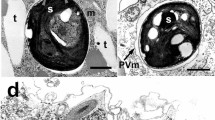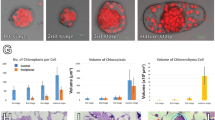Abstract
IN order to understand the mechanism by which various organic molecules are accumulated by the vacuoles of the green alga Nitella, it was necessary to determine accurately the relative volumes of cytoplasm and vacuole in the cell. The unusually large size of these cells has made the genus popular as a tool for the study of biological transport mechanisms1–5. Single cells can be obtained up to nearly 2 mm. in diameter and more than 10 cm. in length. The contents of the large vacuole can be obtained relatively free of cytoplasm by cutting off one end and gently squeezing the solution on to a microscope slide or into a capillary para tube. There seems to be little agreement in the literature concerning the relative volumes of cytoplasm and vacuole. Thus Brooks1 arrived at a value based on intracellular distribution of radioactive potassium and estimated 33 per cent cytoplasm, 67 per cent vacuole. Holm-Jensen et al.2 measured the depth of the immobile chloroplast layer plus the streaming cytoplasm by differential focusing with a water-immersion objective, and the diameter of the cell with a micrometer eyepiece in a dissecting microscope. Calculations from their results give values of 10 per cent cytoplasm, 90 per cent vacuole. Recently, MacRobbie and Dainty4, measuring the rate of loss of sodium-22 from Nitellopsis cells previously loaded with the isotope, calculated that the cytoplasmic compartment consisted of about 3 per cent of the cell. In a similar fashion, using potassium-42, Diamond and Solomon5 arrived at values of 1.8 per cent cytoplasm.
This is a preview of subscription content, access via your institution
Access options
Subscribe to this journal
Receive 51 print issues and online access
$199.00 per year
only $3.90 per issue
Buy this article
- Purchase on Springer Link
- Instant access to full article PDF
Prices may be subject to local taxes which are calculated during checkout
Similar content being viewed by others
References
Brooks, S. C., J. Cell. Comp. Physiol., 11, 247 (1938).
Holm-Jensen, I., Krogh, A., and Wartiovaara, V., Act. Bot. Fenn., 36, 3 (1944).
Litwack, G., and Pramer, D., Arch. Biochem. and Biophys., 68, 396 (1957).
MacRobbie, E. A. C., and Dainty, J., J. Gen. Physiol., 42, 335 (1959).
Diamond, J. M., and Solomon, A. K., J. Gen. Physiol., 42, 1105 (1959).
Author information
Authors and Affiliations
Rights and permissions
About this article
Cite this article
SALTMAN, P., CHRISTENSEN, T. Relative Volumes of Cytoplasm and Vacuole in Nitella. Nature 191, 825–826 (1961). https://doi.org/10.1038/191825a0
Issue Date:
DOI: https://doi.org/10.1038/191825a0
This article is cited by
-
Accumulation of copper in the cell compartments of charophyte Nitellopsis obtusa after its exposure to copper oxide nanoparticle suspension
Environmental Science and Pollution Research (2017)
-
Ionic Relations of Chloroplasts in vivo
Nature (1968)
Comments
By submitting a comment you agree to abide by our Terms and Community Guidelines. If you find something abusive or that does not comply with our terms or guidelines please flag it as inappropriate.



